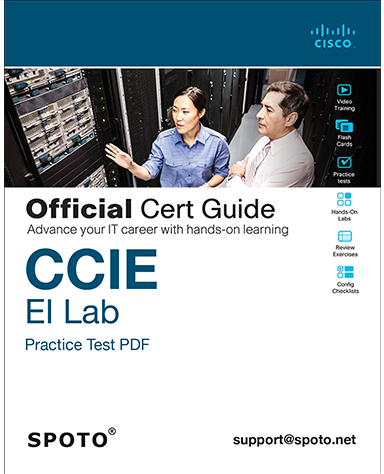Cisco SD-Access Training Course Aligned with Cisco CCIE Certs
CCIE Certified Tutor | Understanding Cisco Software-Defined Access Now with Hand-On Practice
- Experienced instructors with industry expertise
- Access to official guides and materials
- Covers all exam topics thoroughly
- Flexible study at your own pace
- Support for exam service
- Anytime access to study resources
What you'll learn
Training Course Outline
Cisco SD-Access Training Aligned with Cisco CCIE Certs
Lecture 1 SD Access?Elementary course
1: Exploring Cisco SD-Access and Cisco SDN Solution
2: SD-Access Overview Part1
3: SD-Access Overview Part2
4: Introduce SD-Access Topology
5:Design Site
6: Discover devices and assign to site
7:Deploy Overlayer
8: ISE manage user group
9: Set Policy
10: Border and Fusion
11: Host onboarding
Lecture 2 SD Access Advanced Course
12: LISP On SD-Access Deep Dive
13: Policy-Cisco Trust Sec
14: Multi-Site
15: Automation
16: Assurance
Training Options
Self Paced Learning
- Lifelong access to high-quality content
- Curated by industry experts
- Customized learning progress
- 24/7 learner assistance and support
- Follow the latest technology trends
Exam Dump
- 100% Real Exam Practice Tests
- 100% Verified Exam Questions & Answers
- 100% Guarantee Passing Rate
- Average 7 Days to Practice & Pass
Description
SPOTO SD-Access course teaches you how to successfully deploy the Cisco? Software-Defined Access (SD-Access) solution in your enterprise network. SPOTO’s training with corresponding contents for the new knowledge points of CCIE Enterprise Infrastructure Lab, after training, you will have a solid foundation to make preparation for CCIE EI Lab exam and advance your career with latest Cisco technology skills. SPOTO advanced-level, instructor-led, lab-based, hands-on course covers SD-Access fundamentals, provisioning, policies, wireless integration, border operations, and migration strategies. Students will be able to deploy a Cisco SD-WAN over any transport (MPLS, Broadband, LTE, VSAT etc.) and provide management, policy control and application visibility across the enterprise.
Pre-requisites
There is no specific prerequisites but you should have CCNA level of knowledge for Routing & Switching.

SPOTO CCIE EI Lab DOO SDN demon.PDF
SPOTO offers the latest CCIE EI Lab solutions and workbook to help you prepare and pass the lab exam at first try.
Cisco SD-Access Certification Exam FAQs
What is the purpose of Cisco SD-Access?
Cisco SD-Access is a software-defined networking (SDN) solution designed to simplify and automate network management, especially in large enterprise environments. It is a core component of Cisco’s Digital Network Architecture (DNA), aiming to create a secure, automated, and intent-based network. By leveraging SDN principles, SD-Access abstracts the physical network infrastructure, enabling administrators to define network policies and configurations centrally rather than managing individual devices manually. Its primary purpose is to enhance network agility, security, and ease of management.
How does SD-Access differ from traditional networking approaches?
Cisco SD-Access differs from traditional networking by employing a fabric-based architecture instead of relying on manual, device-by-device configuration. This architecture includes:
- Underlay: The physical network infrastructure, such as switches and routers.
- Overlay: A virtual network layer built on top of the underlay, handling logical connections and services.
This separation allows SD-Access to implement policies and services flexibly through the overlay without requiring changes to the physical underlay. In contrast, traditional networking often involves labor-intensive, manual updates to each device, making it less scalable and adaptable compared to SD-Access.
What are the key components of SD-Access?
The key components of Cisco SD-Access include:
- DNA Center: A centralized management platform that provides automation, policy enforcement, and network monitoring capabilities.
- Fabric Infrastructure:
- Edge Nodes: Connect end-user devices (e.g., computers, phones) to the fabric network.
- Border Nodes: Act as gateways, linking the SD-Access fabric to external networks like the internet or other internal segments.
- Control Plane Nodes: Manage endpoint mappings and enforce network policies within the fabric
These components work together to form a scalable and manageable network fabric.
How does SD-Access improve network security?
Cisco SD-Access enhances network security through several features:
- Automated Threat Detection and Response: It identifies and mitigates threats in real time using integrated security tools.
- Micro-Segmentation: Divides the network into smaller, isolated segments to limit the spread of threats and restrict access to authorized users/devices only.
- Policy-Based Access Control: Ensures consistent enforcement of security policies across the network, reducing vulnerabilities caused by manual configuration errors.
What are the benefits of using SD-Access in an enterprise environment?
In enterprise settings, Cisco SD-Access provides numerous advantages:
- Simplified Network Management: Automation reduces the complexity and time required to configure and maintain networks.
- Enhanced Security: Features like micro-segmentation and automated threat response bolster protection across the enterprise.
- Increased Flexibility: The overlay network allows rapid deployment of policies and services without altering the physical infrastructure.
- Adaptability to Change: Enterprises can quickly scale the network or integrate new applications to meet evolving business demands.
These benefits make SD-Access an effective solution for modernizing enterprise network infrastructure.